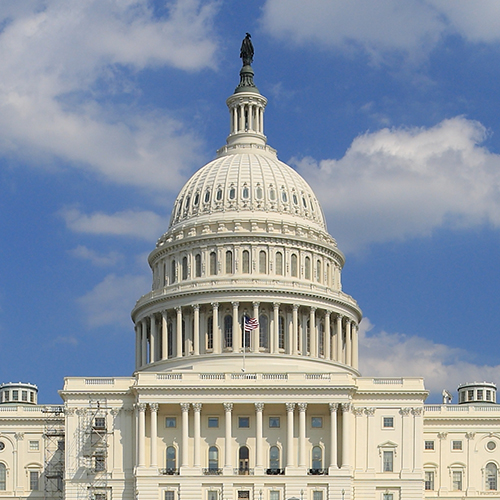David Domke remembers the moment when a president’s use of religious language first grabbed his attention. It was the evening of September 11, 2001, and George W. Bush was addressing the nation regarding the day’s tragic events.

“The president quoted Psalm 23— ‘Even though I walk through the valley of the shadow of death, I fear no evil, for You are with me,’” recalls Domke. “His use of a psalm in his speech concerned me as a citizen because it helped to frame America’s response in religious terms. At the same time, it intrigued me as a scholar.”
Domke, professor in the Department of Communication, continued to notice religious references in subsequent Bush speeches. In 2003, he decided to systemically study the Bush administration’s emphasis on religion in its messages. His findings are published in his 2004 book, God Willing?
The book prompted more questions. People kept asking Domke whether George W. Bush was unusual among presidents in his dependence on religious rhetoric. The question was posed so often that Domke eventually decided to find out.
He began conducting research with communications student Kevin Coe (BA ‘02, MA ‘04), now a doctoral candidate at the University of Illinois. Domke and Coe studied the speeches, proclamations, party platforms, and Christmas celebrations of every president since Franklin Delano Roosevelt. What they found—and describe in their new book, The God Strategy: How Religion Became a Political Weapon in America—was a marked increase and important shifts in the use of religion in political messaging beginning in the 1980s.
“Faith has always been part of politics,” says Domke, “but it became apparent that the turning point was Ronald Reagan. That’s when we began seeing a distinctly religious approach to the White House that benefited the president politically and often in a partisan way. Across all of the different kinds of text we studied, it was an amazing pattern. All the evidence just kept pointing to Reagan.”
Why Reagan? Domke cites Reagan’s predecessor, Jimmy Carter, as a factor. Carter was not shy about discussing his Southern Baptist evangelical faith during his candidacy, and religious conservatives helped him win the election. But once in office, Carter did not use his faith as a political tool.
“The religious conservatives weren’t happy with Carter,” says Domke. “In the next election, it was clear that their vote was up for grabs. Both Republicans and Democrats realized that fundamentalists and conservative evangelicals were going to be a sizable voting block, now engaged in a way that they hadn’t been for decades.”
Reagan responded by adopting what Domke and Coe describe as “the God strategy.” “We call it that because there is clearly a strategic dimension to it,” says Domke. “A president may be genuinely religious or not, but talking about it, and deciding when and where to say it, is a choice.”
In the book, Domke and Coe analyze two types of religious talk in national
addresses by presidents: “faith talk” and “invocations of God.” Faith talk involves the use of faith-laden terms such as sin, grace, blessing, evil, and pray. (Domke
and Coe have created a list of more than 100 such terms, which can be found at
the book’s website at www.thegodstrategy.com.) Invocations of God are explicit
references to a higher power. Since Reagan’s presidency, faith language by presidents has increased by almost 60 percent, while invocations of God have increased
by almost 120 percent.
The researchers also studied two styles of invoking God. Presidents have used the “petitioner style” to thank God or request something of God, such as protection
during war. But when they use the “prophetic style,” they speak as if they know what God wants.
Domke offers the example of George W. Bush’s 2003 State of the Union address. Bush justified the invasion of Iraq by saying, “The liberty we prize is not America’s gift to the world, it is God’s gift to humanity.” Domke sees that as “a declaration of God’s wishes.” He says, “It is an attempt to put God’s stamp on a policy as a way to pre-empt or shut down dissent. By disagreeing with the policy, you are told you’re disagreeing with God.”
Prior to Reagan, whenever presidents explicitly connected the nation with God in their national addresses, they used the petitioner speaking style 80 percent of the time. Now the prophetic style has become far more common. “Of all recent presidents, Ronald Reagan and George W. Bush have used this the most,” says Domke. “Bush is the apex of this speaking style.”
Domke points out that his data show that both Republicans and Democrats have used the God strategy. Democratic president Bill Clinton is right up there with recent Republican presidents when it comes to the use of religion as a political tool.
Domke and Coe express concern about this increased mingling of religion and politics.
“The vast majority of Americans are people of religious faith,” says Domke, “but I am concerned that this is a very dangerous pattern for democracy. If political candidates can frame their messages in terms of religion and then stamp their policies with ‘God’s will,’ there can be dangerous consequences. We’ve seen it repeatedly throughout history. Kevin and I see politics and religion as distinct tapestries in the American story. They are woven together, but they should not be fused.”
More Stories

Is This Presidential Campaign Different?
UW History professor Margaret O'Mara provides historical context for this moment in US presidential politics.

Making Sense of This Political Moment
To navigate this momentous election season, Arts & Sciences faculty suggest 10 books about the US political landscape.

A Statistician Weighs in on AI
Statistics professor Zaid Harchaoui, working at the intersection of statistics and computing, explores what AI models do well, where they fall short, and why.